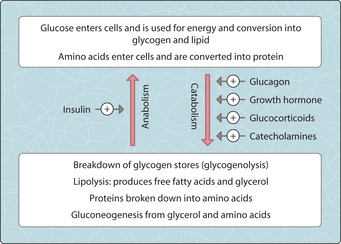Chapter 51 Diabetes mellitus: pathophysiology
Diabetes mellitus is a chronic disorder caused by inadequate insulin action; this can arise either from impaired insulin production or from resistance of target organs to insulin action. There are consequent abnormalities of carbohydrate, fat and protein metabolism. Its hallmark is hyperglycaemia (increased blood glucose concentration). This chapter covers the pathophysiology; the complications of diabetes are described in Ch. 52.
Insulin
It also inhibits the use of fats and proteins for energy. The net result is that the concentration of glucose in the blood tends to fall (hypoglycaemic effect). Insulin is the only hormone in the body that has this effect, whereas there are several hormones that tend to have a hyperglycaemic effect, and the hyperglycaemic actions of these hormones cannot be adequately opposed if insulin action is deficient (Fig. 3.51.1).
Consequently, the major effects of insulin deficiency are catabolic: that is, there is breakdown of energy stores in the tissues. Lipolysis converts fats into free fatty acids and glycerol; proteins are broken down into amino acids, which are then used for glucose production (gluconeogenesis), and glycogen is cleaved into glucose molecules. Thus, the excess circulating glucose in diabetics is derived from ingested glucose that cannot be taken up by the cells and also from the breakdown of alternative energy stores (fat, glycogen and protein; Fig. 3.51.1).
Stay updated, free articles. Join our Telegram channel

Full access? Get Clinical Tree














